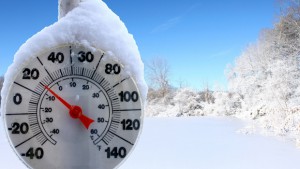
Provided by T.E. Smith & Son
Protect and prepare outdoor plumbing pipe and fixtures for winter temperatures
- Frost resistant faucets should be disconnected from all hoses and the hoses should be drained and stored for the winter. Frost resistant faucets are installed to allow drainage when turned off. When the frost free faucet is turned off, the washer is actually stopping the water back inside the heated envelope of the structure; the barrel housing the faucet stem then drains automatically which makes it more difficult for the faucet to freeze. When frost resistant hydrants are installed without proper grade, to allow for drainage, or when hoses are left connected to exterior faucets, the facet will not drain properly and can freeze within the wall cavity, basement or crawlspace. Many times, when piping freezes, the expanding ice will split the barrel of the faucet causing a leak that will only be detected when placed back in service, causing a deluge of water within the crawlspace or wall cavity.
- When winterizing exterior piping, showers and plumbing fixtures that are only used during warm weather, make sure to purge the piping and add antifreeze to domestic water piping, traps and drainage piping that hold water and are prone to freezing. Regular glycol antifreeze can be used for most drainage piping systems, but it is important that only ‘food grade’ polypropylene antifreeze be used in domestic water systems where someone could drink the water when it is placed back in service. When de-winterizing exterior domestic water systems, polypropylene should be removed from the piping systems by running the water thoroughly until no color can be detected in the water. (Food grade polypropylene is typically has a red or orange color, but that is not an industry standard)
- Check boiler rooms, basements and crawl spaces that have exposed pipes and make sure that these areas are not exposed to freezing temperatures or wind. Insulation helps, but will not stop freezing if piping systems are left exposed to freezing temperatures. Thermostatically controlled heat tape should be used together with insulation in unheated areas. Plumbing pipes that are exposed to cold air, especially those located in laundry rooms, bathrooms and garages are at risk for freezing. Wind-chill and freezing winds are the main causes of frozen pipes. Make sure that all block vents, access doors and openings that allow wind to affect plumbing piping are closed and/or sealed and insulated.
- If your residence is built on a crawl space and if you have a ground cover such as polyethylene over the entire crawl space, the block vents around the residence should be left closed year round and insulated if the block vent will allow air penetration into the structure. The reasoning behind this is to maintain a consistent temperature year round within the crawl space by maintaining a sealed envelope, and by means of natural thermal migration, allowing the temperature within the occupied space to regulate the temperature within the crawl space.
- It is always important to maintain the weather stripping in commercial and residential applications. Infiltration of air around windows and doors wastes 10 – 15% of yearly energy costs. Please check out this link for tips on the various types of weather stripping and their applications. http://energy.gov/energysaver/weatherstripping
WARNING: NEVER THAW FROZEN PIPES WITH TORCHES OR OPEN FLAME DEVICES…USE A HAIR DRYER OR AN APPROVED THERMOSTATICALLY CONTROllED HEAT TAPE.
Protect and prepare your HVAC systems for winter temperatures
- One of the most important things that you can do to save money and to extend the life of your HVAC systems is to perform regular maintenance on your HVAC systems. This should be scheduled in late September or early October. You should schedule this before the cold weather comes, so that you are confident that you will have heat when you need it and your family will be comfortable as well as safe.
- Remove flammable items near the furnace. Items that may have been stored next to the furnace over the summer such as weed whackers, lawn movers, gas cans, etc., should be removed for safety. Never leave flammable items near an open flame.
- Change and/or clean your air filter. Air Filters should be cleaned and/or changed at least every three months, and more often if they look dirty. This should especially be done during heavy use seasons such as summer and winter. A dirty filter will slow down air flow and make the system work harder, wasting energy and your hard earned dollar. A clean filter will keep dirt and dust out of your system, increasing its longevity and reducing the need for expensive repairs.
- Check your thermostat’s programming to make sure it reflects your family’s current schedule. You should reexamine your thermostat’s settings each season not only to keep your family comfortable but to help reduce energy costs.
- Check your chimney. Make sure there are no cracks or loose bricks in your chimney and that it is free of debris.
WARNING: Carbon Monoxide (CO) is dangerous and is a byproduct of burning fuels in automobiles, small engines, stoves, lanterns, grills, fireplaces, gas ranges and furnaces. CO can build up indoors and poison people and animals who breathe it. Carbon monoxide is odorless and tasteless and can kill you within a matter of minutes when you are exposed in an area that is not well vented. If you have a fuel fired stove, furnace or hydronic boiler, a carbon monoxide detector is an absolute necessity. Make sure that your CO detector has an audible alarm and you change batteries on a regular predetermined schedule. Make sure your CO detectors are working properly and located at strategic locations throughout the occupied space especially in rooms where you tend to spend the most time such as bedrooms and living rooms with a fireplace, stove or space heater. Be sure that it has been installed in the appropriate location in your home; near your sleeping area is the best location. Now would be a good time to replace the batteries in your CO detector.
Where is CO found?
CO is found in fumes produced any time you burn fuel in cars or trucks, small engines, stoves, lanterns, grills, fireplaces, gas ranges, or furnaces. CO can build up indoors and poison people and animals who breathe it.
What are the symptoms of CO poisoning?
The most common symptoms of CO poisoning are headache, dizziness, weakness, upset stomach, vomiting, chest pain, and confusion. CO symptoms are often described as “flu-like.” If you breathe in a lot of CO it can make you pass out or kill you. People who are sleeping or drunk can die from CO poisoning before they have symptoms.
Who is at risk from CO poisoning?
Everyone is at risk for CO poisoning. Infants, the elderly, people with chronic heart disease, anemia, or breathing problems are more likely to get sick from CO. Each year, more than 400 Americans die from unintentional CO poisoning not linked to fires, more than 20,000 visit the emergency room, and more than 4,000 are hospitalized. Have your gas or oil fired heating system serviced annually.
How can I prevent CO poisoning in my home?
- Install a battery-operated or battery back-up CO detector in your home and check or replace the battery when you change the time on your clocks each spring and fall.
- Have your heating system, water heater, and any other gas, oil, or coal burning appliances serviced by a qualified technician every year.
- When you buy gas equipment, buy only equipment carrying the seal of a national testing agency, such as Underwriters’ Laboratories.
- Make sure your gas appliances are vented properly. Horizontal vent pipes for appliances, such as a water heater, should go up slightly as they go toward outdoors. This prevents CO from leaking if the joints or pipes aren’t fitted tightly.
- Have your chimney checked or cleaned every year. Chimneys can be blocked by debris. This can cause CO to build up inside your home or cabin.
- Never patch a vent pipe with tape, sealant gum, or something else. This kind of patch can make CO build up in your home, cabin, or camper.
- Never use a gas range or oven for heating. Using a gas range or oven for heating can cause a buildup of CO inside your home, cabin, or camper.
- Never burn charcoal indoors. Burning charcoal – red, gray, black, or white – gives off CO.
- Never use a portable gas camp stove indoors. Using a gas camp stove indoors can cause CO to build up inside your home, cabin, or camper.
- Never use a gas fired generator inside your home, enclosed garage or unventilated area.
- Upon hearing a CO alarm, evacuate the affected area immediately and call the fire department.





